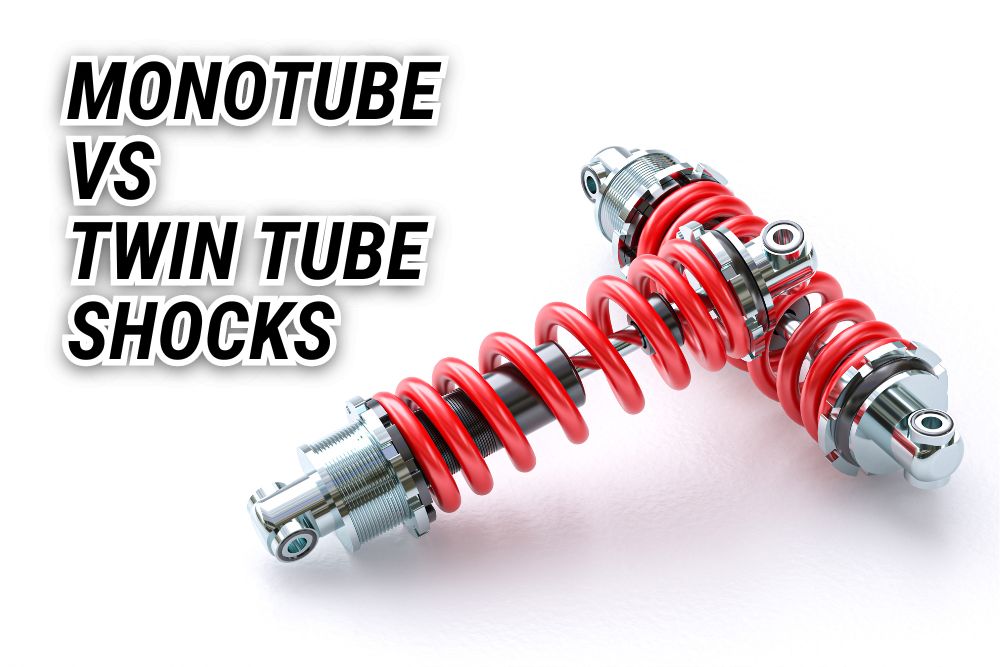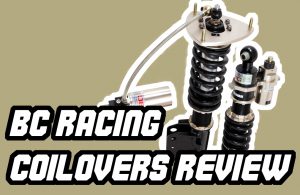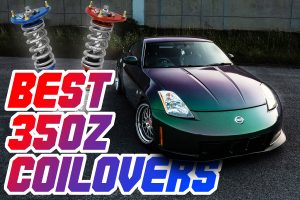Monotube Vs Twin Tube Shocks: The Ultimate Guide
If you are looking to buy new coilovers, there are two main types of shocks you will come across: Twin tube and monotube shocks.
In this blog post I will cover what the difference between twin tube and monotube shocks is, and how to select the right ones for your car.
Quick Summary: Twin Tube Vs Monotube Shocks
Monotube shocks are typically better for performance and fast driving. They handle heat well, don’t foam up, and can be installed at any angle, making them good for kit cars and custom installations as well. However, they are typically more expensive than twin tubes and provide a less comfortable ride.
Twin-tube shocks are commonly found in most regular cars from factory. They make your ride smoother and more comfortable, and usually cost less than monotubes. But their downside is they don’t handle heat as well and are less responsive, which makes them less ideal for performance driving.
Choosing the right shocks depends on your car, how much you want to spend, and how you intend to drive the car. If you go to the track regularly, monotube shocks are usually the better option. If you want comfort for the street, twin-tube shocks are the better way to go.
Keep reading to find out more about the differences between these shocks and how to select the right ones (there is more to it).
Understanding Car Shocks
To understand the difference between monotube and twin-tube shocks, it’s important to know what these parts do in your car. They’re a major part of your car’s shock absorber system, which helps your car’s suspension work properly.
In simple terms, shocks are like hydraulic pumps that help manage the bounce and movement of your car’s springs and suspension. They make sure your tires stay on the ground, which gives your car stability and a smoother ride. However, not all shocks are the same. They differ in their design and how they’re made.
Monotube shocks, for instance, have a single cylinder design with a fluid area and a gas chamber. This design makes them work better, react faster, and provide more damping force when the car moves aggressively.
On the flip side, twin-tube shocks have two cylinders – an inner working cylinder and an outer storage area. They’re a cheaper option and are commonly used in most cars because they tend to be more comfortable, but they aren’t as responsive as monotubes.
Knowing these basic facts about shock absorbers and suspension systems can help you choose between monotube and twin-tube shocks for your car.
Monotube Shocks
Let’s dive into the details of monotube shocks.
These shocks have one cylinder (thus the name monotube) and offer many benefits, but they also have possible downsides.
Advantages of Monotube Shocks
Superior Damping Performance
Monotube shocks are better than twin-tube shocks in offering control and response.
Here are three main reasons why:
- Their design allows for a larger piston surface area, which allows it to react faster and be more responsive
- Monotube shocks stop air from mixing with the oil, which allows them to perform more consistently
- Due to their design and extra oil capacity, they don’t get as hot, so they’re less likely to get damper fade when you’re driving hard.
In simple terms, if you want better control and faster response, monotube is the best choice.
Enhanced Cooling Capacity
Monotube shocks are a great choice for performance driving because they manage temperature better than twin tubes.
They have separate oil and gas chambers, which stops the oil and gas from mixing, so there’s no foaming and heat can escape more easily.
They also have more oil capacity, which helps keep them cool. This better cooling ability helps maintain steady performance, even under extreme conditions.
Reduced Aeration (Foaming) Risk
Monotube shocks have separate areas for the oil and gas which helps to prevent foaming. This makes them last longer during hard driving and prevents damper fade, even under tough conditions.
More Setup Choices
Monotubes can be installed in many ways, even upside down. This can be useful for custom installations on kit cars and other interesting projects, as well as inverted setups for track use.
Disadvantages of Monotube Shocks
Monotube shocks have some great features, but they also have some downsides to think about.
Due to their design, they offer more response and feel, but this can also make them less comfortable on the street compared to twin tubes due to the high pressure gas.
Monotubes are also more complex to make so they tend to cost more.
Some monotubes can also have a shorter lifespan, such as with inverted setups, due to applying more pressure and wear on the seals.
Another potential negative is since their design is “stacked”, with the oil chamber above the gas chamber, you don’t get as much stroke from the shock, which can be a problem if you are running the car low.
One last potential drawback (though in my opini0n not a significant one) is that since they are a single tube design, if the outer tube gets damaged, the shock is typically done for. Twin tubes, on the other hand, can continue to function with the outer tube damaged (to a degree).
Twin-Tube Shocks
Now let’s take a look at twin tube shocks.
Twin tube shocks have two main parts: an inner tube and an outer tube. The inner tube is where the piston operates, and the oil gets pushed from the inner tube into the outer tube. The gas sits at the top of the outer tube.
This is an older design and is also cheaper to make than monotubes.
They are usually come fitted in cars, small trucks, SUVs, and vans from factory.
The Benefits of Twin-Tube Shocks
There are four main benefits of twin tubes:
- They are less expensive to make so they are cheaper to buy
- They are more comfortable for street use due to their low pressure design
- They tend to be very reliable and don’t wear the seals or cause as much friction as monotubes
- Damage to the outer tube won’t affect them
Disadvantages of Twin-Tube Shocks
There are a few downsides to twin-tube shocks you should know about.
One big problem is how they’re installed. Unlike monotubes, twin-tube shocks have to be put in at certain angles. If not, they won’t work as well. In fact, if you install them upside down, they won’t work at all. This means you are limited to using them only in upright applications.
Another problem is that they don’t handle heat well and can get too hot easily. The way twin-tube shocks are made makes them hold on to heat, and then they won’t do their job properly.
They are also much more susceptible to foaming since there isn’t a separation between the oil and gas like there is on monotubes.
Another downside is that, due to having an inner tube, they can’t use as big of a piston, which makes them less responsive when compared to monotubes.
They also have less oil capacity than monotubes, which means they won’t last as long and will heat up quicker under hard driving and extreme conditions.
Comparing Monotube and Twin-Tube Shocks
The simplest way to compare these two are:
- If you plan to use your car at the track, or you like to drive hard, get monotube shocks
- If your priority is comfort, and you are willing to sacrifice performance, get twin tubes
Ride Quality
The ride quality is higher on twin tubes due to their low pressure design. They will be more comfortable on the street, and you will feel less of the bumps and suspension movements.
Monotubes will be more responsive and give you more feel, but that can affect the ride comfort since you will feel more.
Performance
Monotubes win on performance hands down, which is why most coilover companies use monotubes. They are more responsive, give you more feel, and handle heat better for longer periods. There isn’t much more to say about it.
Longevity
Twin tubes tend to last longer since they don’t cause as much friction and wear on the seals. But if you are after performance, chances are you are already willing to sacrifice some longevity. In any case, it’s not like all monotubes will only last 10,000kms (good ones anyway).
Factors to Consider When Selecting Shocks
When picking shocks for your car, here are the three main things to think about:
- How and Where You Drive: Monotube and twin-tube shocks work differently in different situations. Monotube shocks are great for fast driving and high-performance uses, while twin-tube shocks are better for regular, everyday driving.
- Performance Factors: Monotube shocks give you better control, react quickly, and handle heat better than twin-tube shocks. But, twin-tube shocks are more comfortable, cheaper and will probably last longer.
- Budget: You need to factor in what you can afford. You’ll find that many of the cheaper (sub $1000) coilover kits use twin tubes, whereas most of the more expensive kits (especially performance orientated ones) will use monotubes.
In the end, the best shock for your car depends on what you like, how much you want to spend, and how you plan to use your vehicle.
Which Coilover Brands Have Which Shocks?
Monotube
Most coilover brands have monotube shocks due to the fact that coilovers are typically made for performance.
This includes:
- BC Racing
- Fortune Auto
- Riaction
- Silvers
- HKS
Twin Tube
However, there are a number of coilover brands that have twin tube shocks, such as:
- TEIN (up to Flex Z models)
- KW
- Solo-Werks
Conclusion
Deciding on monotube or twin-tube shocks depends on what you need and how you drive.
Monotube shocks are great for high performance driving and will withstand harsher conditions.
Twin-tube shocks are better if you want a comfortable ride and are looking for a less expensive option.
If you need help selecting the right coilovers for your car, send me an email on info@nefariousracing.shop and I’ll help you select the right kit.
- BC Racing Coilovers Review – Are They Any Good? - September 12, 2024
- 8+ Best Nissan 350Z Coilover Guide In 2024 - September 12, 2024
- Top 6 Best 2015 Subaru WRX Coilovers - September 12, 2024




